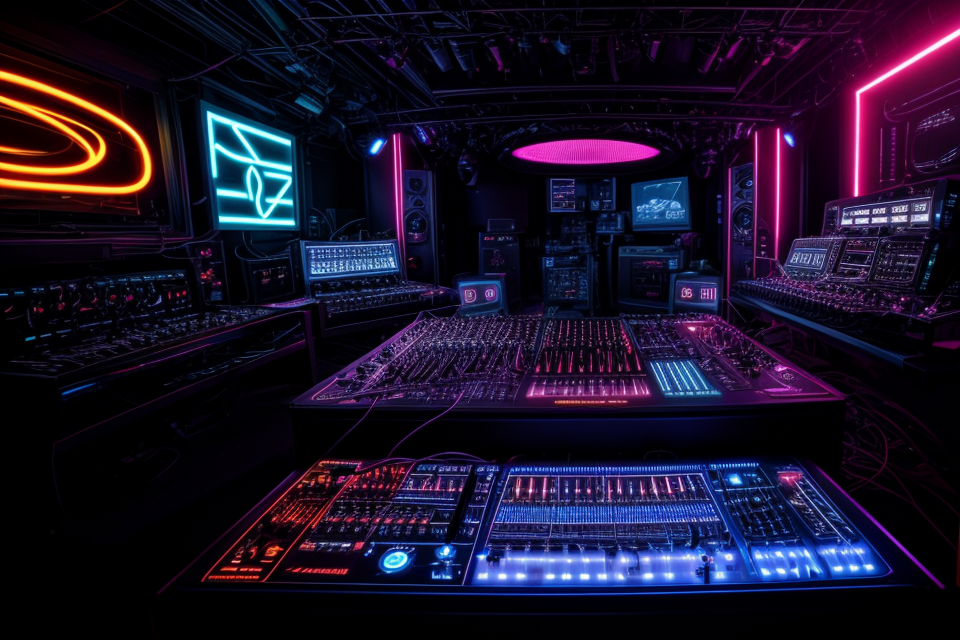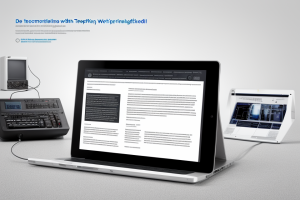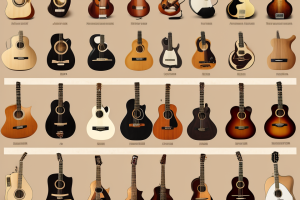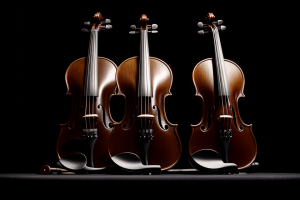
Electronic musical instruments (EMIs) have come a long way since their inception in the mid-20th century. They are now an integral part of modern music production and performance, with a wide range of sounds and functions that can be easily integrated into any music project. From synthesizers to drum machines, these instruments offer a vast array of creative possibilities for musicians and producers of all genres. In this comprehensive guide, we will explore the world of electronic musical instruments, examining their history, technology, and cultural impact. We will also provide tips and tricks for getting the most out of these versatile tools, whether you’re a beginner or an experienced musician. So let’s dive in and discover the magic of EMIs!
What are Electronic Musical Instruments?
Definition and Overview
Electronic musical instruments (EMIs) are devices that generate, manipulateulate, and produce sound through the use of electronic circuits, computers, and other technology. Unlike traditional acoustic instruments, EMIs do not rely on mechanical or physical means to produce sound, but instead use electronic signals to create and modify audio signals. EMIs come in a wide range of forms, from simple synthesizers and drum machines to complex digital audio workstations (DAWs) and virtual instruments. They are used in a variety of musical genres and contexts, from popular music to classical composition and film scoring.
EMIs can be divided into two main categories: hardware and software. Hardware EMIs are physical devices that contain their own electronics and are played or controlled using physical interfaces such as keys, knobs, and buttons. Software EMIs, on the other hand, are computer programs that can be run on a variety of devices, including desktop and laptop computers, tablets, and smartphones.
EMIs offer a wide range of creative possibilities for musicians and producers, including the ability to create and manipulate new sounds, experiment with different sonic textures and timbres, and automate musical processes. They also allow for easy editing and manipulation of recorded audio, making it possible to create complex arrangements and mixes with ease.
In summary, EMIs are a diverse and versatile class of musical instruments that use electronic technology to generate, manipulate, and produce sound. They offer a wide range of creative possibilities for musicians and producers, and are an essential tool for many styles of music.
Types of Electronic Musical Instruments
Electronic musical instruments (EMIs) are devices that generate, manipulateulate, and reproduce sound using electronic circuits, computers, and other technology. They are designed to produce a wide range of sounds, from realistic imitations of traditional instruments to entirely new and unique timbres.
There are many different types of EMIs, each with its own unique features and capabilities. Some of the most common types include:
- Synthesizers: These are devices that generate a wide range of sounds by manipulating various parameters such as frequency, amplitude, and waveform. There are many different types of synthesizers, including analog, digital, and hybrid models.
- Samplers: These are devices that store and play back sounds recorded from real instruments or other sources. Samplers can be used to create realistic instrumental sounds or to create new and unique timbres by manipulating the sampled sounds.
- Drum machines: These are devices that generate and play back drum sounds, often in a rhythmic pattern. They are commonly used in electronic music production and live performance.
- Sequencers: These are devices that automate the playing of notes and other MIDI data, allowing for the creation of complex musical patterns and sequences.
- Effects processors: These are devices that alter the sound of an instrument or audio signal, adding effects such as reverb, delay, distortion, and filtering.
- MIDI controllers: These are devices that allow musicians to control electronic sounds and parameters using physical gestures, such as pressing keys or turning knobs.
- Digital audio workstations (DAWs): These are software programs that allow musicians to create, record, edit, and mix music using a computer.
Overall, the world of electronic musical instruments is vast and diverse, with new technologies and innovations constantly emerging. By understanding the different types of EMIs available, musicians can choose the tools that best suit their needs and creative goals.
How Electronic Musical Instruments Work
Basic Components of Electronic Musical Instruments
Electronic musical instruments (EMIs) rely on a variety of components to produce and manipulate sound. Understanding these basic components is essential for grasping how EMIs work and how they differ from traditional acoustic instruments. Here are some of the most important components:
Synthesizer Circuitry
Synthesizer circuitry is the backbone of most EMIs. It generates sound by creating and manipulating electrical signals. There are two main types of synthesizers: analog and digital. Analog synthesizers use analog circuits to generate and manipulate sound, while digital synthesizers use digital signal processing techniques.
Sound Generators
Sound generators are the devices that produce the basic sounds that are then modified by the synthesizer circuitry. There are many different types of sound generators, including oscillators, noise generators, and sample-and-hold devices.
Modulation Sources
Modulation sources are used to modify the sound generated by the synthesizer circuitry. They include envelope generators, which shape the volume of the sound over time, and low-frequency oscillators (LFOs), which modulate the pitch or other parameters of the sound.
Filter Section
The filter section is responsible for shaping the timbre of the sound. It works by selectively removing or boosting certain frequencies in the sound. There are many different types of filters, including low-pass filters, high-pass filters, and band-pass filters.
Effects Processors
Effects processors are used to add special effects to the sound. They include reverb, delay, distortion, and many others. Some EMIs have built-in effects processors, while others may have external effects units that can be connected to the instrument.
User Interface
The user interface is the part of the EMI that the player interacts with. It includes controls for adjusting the various parameters of the instrument, such as the synthesizer circuitry, sound generators, modulation sources, filter section, and effects processors. The user interface may include knobs, sliders, buttons, and other controls.
Understanding these basic components is essential for understanding how EMIs work and how they can be used to create a wide range of sounds.
Sound Generation and Amplification
Electronic musical instruments (EMIs) use various methods to generate and amplify sound. This section will delve into the technical aspects of how EMIs produce and project their sound.
Analog Synthesis
Analog synthesizers are based on a variety of sound generation techniques, such as subtractive synthesis, where a basic waveform is altered by filtering and amplification, and additive synthesis, where sound is created by adding various harmonic components together. Analog synthesizers can produce a wide range of timbres and are capable of creating complex and evolving sounds.
Digital Synthesis
Digital synthesizers use mathematical algorithms to generate sound. They can produce a vast array of timbres, from realistic instruments to entirely new and unique sounds. Digital synthesizers are highly versatile and can be used to create a wide range of musical styles.
Sound Modification
EMIs use various techniques to modify and shape the sound produced by the synthesizer. This can include filtering, which removes or emphasizes certain frequency ranges, and distortion, which alters the shape of the waveform. These techniques can be used to create a wide range of timbres and effects.
Amplification
EMIs use amplifiers to project the sound generated by the synthesizer. Amplifiers can be used to adjust the volume of the sound and shape the tone. Many EMIs also include built-in effects processors, which can be used to further modify the sound before it is amplified.
Overall, the sound generation and amplification process in EMIs is a complex interplay of various techniques, allowing for a wide range of timbres and effects to be produced. Understanding these techniques is essential for any musician looking to explore the world of electronic music.
Input Devices and Controls
Electronic musical instruments (EMIs) rely on input devices and controls to enable musicians to interact with the instrument and produce sound. These input devices can include keys, buttons, knobs, faders, and sensors, among others. Each input device serves a specific purpose and can be used to control various aspects of the instrument’s sound production.
MIDI Controllers
MIDI (Musical Instrument Digital Interface) controllers are devices that allow musicians to input notes, control parameters, and trigger sounds using a keyboard-like interface. MIDI controllers can be used to play electronic instruments, trigger sounds in software, or control hardware synthesizers. They are versatile and can be used in a variety of musical genres and contexts.
Faders and Knobs
Faders and knobs are used to control various parameters of the instrument, such as volume, filter cutoff, and reverb levels. Faders are sliders that can be used to adjust levels, while knobs are rotary controls that can be used to tweak parameters. These input devices provide musicians with a tactile and visual way to control the instrument’s sound production.
Pedals
Pedals are used to control various aspects of the instrument’s sound production, such as volume swells, filter sweeps, and pitch bends. They can be used to create expressive performances and add dynamics to the music. Pedals can be found on a variety of EMIs, including synthesizers, drum machines, and effects processors.
Sensors
Sensors are used to detect and respond to physical movements or environmental changes. For example, some EMIs include pressure sensors that can detect the amount of pressure applied to a key or pad, allowing for expressive performances and nuanced sound control. Other sensors can detect the position of a joystick or the angle of a rotary control, allowing for even more complex sound manipulation.
Overall, input devices and controls are essential components of EMIs, providing musicians with the ability to interact with the instrument and produce a wide range of sounds. Understanding how these devices work and how to use them effectively is key to unlocking the full potential of electronic musical instruments.
Popular Electronic Musical Instruments
Synthesizers
Synthesizers are electronic musical instruments that generate sound through the manipulation of electronic signals. They can produce a wide range of sounds, from realistic instrument imitations to entirely new and unique sounds.
There are many different types of synthesizers, including analog, digital, and hybrid models. Analog synthesizers use analog circuits to generate sound, while digital synthesizers use digital signal processing techniques. Hybrid synthesizers combine elements of both analog and digital synthesis.
One of the most popular types of synthesizers is the virtual synthesizer, which is software-based and can be used on a computer or mobile device. Virtual synthesizers offer a wide range of sounds and features, and can be easily edited and customized using a computer or mobile device.
Synthesizers are often used in a variety of musical genres, including electronic, hip hop, and pop music. They are also commonly used in film and television soundtracks, video games, and other multimedia productions.
In recent years, there has been a resurgence in interest in analog synthesizers, as many musicians and producers seek to create unique and authentic sounds. As a result, there has been a growing market for vintage and retro synthesizers, as well as new models that emulate the sound and feel of classic analog synthesizers.
Overall, synthesizers are a versatile and powerful tool for musicians and producers looking to create unique and innovative sounds. Whether you’re a beginner or an experienced musician, exploring the world of synthesizers can be a rewarding and exciting journey.
Digital Pianos and Keyboards
Digital pianos and keyboards are electronic musical instruments that have gained immense popularity in recent years. They are versatile and offer a wide range of features that make them ideal for both beginners and professional musicians. In this section, we will explore the details of digital pianos and keyboards, including their history, types, and benefits.
History of Digital Pianos and Keyboards
Digital pianos and keyboards have been around since the 1970s, but it was not until the 1990s that they became widely popular. The first digital pianos were created by Japanese manufacturers, such as Yamaha and Roland, and were primarily used in recording studios. However, as technology advanced, digital pianos and keyboards became more affordable and accessible to the general public.
Types of Digital Pianos and Keyboards
There are several types of digital pianos and keyboards available in the market today. Some of the most popular types include:
- Stage pianos: These are portable keyboards that are designed for live performances. They usually have a simple layout and a wide range of sounds and effects.
- Portable keyboards: These are lightweight and compact keyboards that are easy to transport. They are ideal for beginners and hobbyists who want to practice on the go.
- Home pianos: These are digital pianos that are designed for home use. They are usually more expensive than portable keyboards but offer a more authentic piano playing experience.
- Arranger keyboards: These are advanced keyboards that come with a wide range of features, including built-in speakers, effects, and a wide range of sounds.
Benefits of Digital Pianos and Keyboards
Digital pianos and keyboards offer several benefits over traditional acoustic pianos, including:
- Portability: Digital pianos and keyboards are lightweight and compact, making them easy to transport.
- Affordability: Digital pianos and keyboards are generally more affordable than acoustic pianos, making them accessible to a wider range of people.
- Customization: Digital pianos and keyboards offer a wide range of sounds and effects that can be customized to suit the user’s preferences.
- Maintenance: Digital pianos and keyboards require minimal maintenance, making them a convenient option for busy musicians.
In conclusion, digital pianos and keyboards are versatile and offer a wide range of features that make them ideal for both beginners and professional musicians. Whether you are looking for a portable keyboard for on-the-go practice or a home piano for serious playing, there is a digital piano or keyboard that is perfect for you.
Drum Machines and Samplers
Drum machines and samplers are two popular electronic musical instruments that have revolutionized the music industry. These instruments are used to create rhythmic patterns and sounds that are essential to many genres of music.
Drum Machines
Drum machines are electronic devices that generate percussive sounds, which are then played through speakers or headphones. They are used to create drum beats and rhythms that can be used in a variety of musical genres. Some of the most popular drum machines include the Roland TR-808, the LinnDrum, and the Alesis Nitro.
Drum machines are versatile and can be used to create a wide range of drum sounds, from classic disco beats to modern hip-hop rhythms. They are also often used in the production of electronic dance music (EDM) and are an essential tool for many DJs and producers.
Samplers
Samplers are electronic musical instruments that allow musicians to record and play back sounds, which can then be manipulated and transformed. They are used to create a wide range of sounds, from synthesizer patches to vocal samples. Some of the most popular samplers include the Akai MPC, the Roland SP-404, and the Elektron Octatrack.
Samplers are versatile and can be used to create a wide range of sounds, from classic synthesizer patches to modern vocal samples. They are also often used in the production of hip-hop and electronic music, and are an essential tool for many producers and DJs.
In conclusion, drum machines and samplers are two popular electronic musical instruments that have played a significant role in the music industry. They are versatile, easy to use, and can be used to create a wide range of sounds and rhythms. Whether you are a professional musician or a beginner, these instruments are a must-have for any music production setup.
Advantages and Disadvantages of Electronic Musical Instruments
Advantages
- Versatility: Electronic musical instruments (EMIs) offer a wide range of sounds and timbres that are not possible with traditional acoustic instruments. This versatility allows musicians to explore new sounds and styles, making EMI an ideal choice for composers, producers, and performers.
- Portability: EMIs are often smaller and lighter than their acoustic counterparts, making them easy to transport and set up. This portability allows musicians to perform in a variety of settings, from small clubs to large concert halls.
- Control: EMIs offer a high degree of control over sound quality, allowing musicians to fine-tune their instruments to achieve the desired sound. This control is especially useful for recording and producing music, as it allows musicians to create a precise and polished sound.
- Durability: EMIs are built to last and are less susceptible to damage than acoustic instruments. This durability makes them an attractive choice for musicians who are looking for long-lasting and reliable instruments.
- Affordability: EMIs are often more affordable than their acoustic counterparts, making them accessible to a wider range of musicians. This affordability is especially important for musicians who are just starting out and may not have the financial resources to invest in expensive instruments.
Disadvantages
Electronic musical instruments (EMIs) have gained immense popularity in recent years due to their versatility and innovative features. However, despite their many advantages, there are also several disadvantages associated with EMIs that need to be considered. In this section, we will explore some of the most significant disadvantages of electronic musical instruments.
Limited Tactile Feedback
One of the primary drawbacks of electronic musical instruments is the limited tactile feedback they provide. Unlike traditional acoustic instruments, EMIs do not require any physical effort to produce sound, which can make it difficult for musicians to develop the necessary physical skills required for playing an instrument. While some EMIs, such as the keyboard, do provide some tactile feedback, others, such as the guitar, may not have the same level of tactile feedback as their acoustic counterparts.
Reliance on Technology
Another significant disadvantage of electronic musical instruments is the reliance on technology. EMIs are heavily dependent on technology, such as amplifiers, speakers, and software, to produce sound. While this technology has advanced significantly in recent years, it can still be prone to malfunctions and technical difficulties. This can be frustrating for musicians who rely on their instruments to create music and may require them to invest in expensive equipment to ensure their instruments function properly.
Limited Durability
Electronic musical instruments can also be less durable than their acoustic counterparts. EMIs contain sensitive electronic components that can be damaged if the instrument is subjected to extreme temperatures, humidity, or other environmental factors. While some EMIs, such as synthesizers, can be more durable than others, such as drum machines, it is essential to take proper care of electronic instruments to ensure they function correctly over time.
Cost
Finally, electronic musical instruments can be more expensive than acoustic instruments, particularly when considering the cost of additional equipment, such as amplifiers and speakers. While some EMIs, such as digital pianos, can be more affordable than their acoustic counterparts, others, such as high-end synthesizers, can be quite expensive. This cost can be a significant barrier for musicians who are just starting out or who have limited financial resources.
In conclusion, while electronic musical instruments offer many advantages, such as versatility and innovative features, they also have several disadvantages that need to be considered. Musicians must weigh the pros and cons of EMIs carefully before deciding whether to invest in one.
Caring for Your Electronic Musical Instrument
Maintenance and Cleaning
Electronic musical instruments, like any other electronic devices, require regular maintenance and cleaning to ensure optimal performance and longevity. Neglecting this crucial aspect of instrument care can lead to damage to the instrument and even result in irreversible damage to the components. In this section, we will discuss some best practices for maintaining and cleaning your electronic musical instrument.
Regular Inspection
The first step in maintaining your electronic musical instrument is to perform regular inspections. Check for any visible signs of damage, such as cracks or loose components, and report any issues to a professional for repair. Regular inspection can help you identify potential problems before they become serious issues.
Dust and Debris
Electronic musical instruments are prone to accumulating dust and debris, which can affect their performance. Regular cleaning can help prevent damage to the instrument and its components. Use a soft, dry cloth to wipe down the exterior of the instrument, and gently remove any dust or debris that has accumulated on the keys or other sensitive areas.
Cleaning the Keys
Cleaning the keys is an essential part of maintaining your electronic musical instrument. Over time, keys can become dirty and may even develop a buildup of dirt and grime. Use a soft, dry cloth to gently wipe down the keys, and avoid using harsh chemicals or abrasive cleaners that can damage the keys or the instrument’s surface.
Cleaning the Screen
If your electronic musical instrument has a screen, it is essential to keep it clean to ensure optimal performance. Use a soft, dry cloth to wipe down the screen, and avoid using harsh chemicals or abrasive cleaners that can damage the screen or the instrument’s surface.
Power Supply
Ensure that your electronic musical instrument is plugged into a power source that is stable and free from any fluctuations or surges. This can help prevent damage to the instrument and its components.
Avoiding Liquids
Avoid exposing your electronic musical instrument to liquids, as this can cause severe damage to the instrument and its components. If you accidentally spill a liquid on the instrument, turn it off immediately and contact a professional for repair.
In conclusion, maintaining and cleaning your electronic musical instrument is an essential aspect of instrument care. Regular inspection, dust and debris removal, cleaning the keys and screen, and ensuring a stable power supply are all essential practices to follow. By following these best practices, you can ensure optimal performance and longevity for your electronic musical instrument.
Storage and Transportation
Proper storage and transportation of your electronic musical instrument (EMI) is crucial to ensure its longevity and optimal performance. Here are some tips to keep in mind:
- Store your EMI in a dry and cool place: High humidity and extreme temperatures can damage your EMI’s sensitive components. It’s best to store it in a dry and cool room, away from direct sunlight and sources of heat.
- Use protective cases: When transporting your EMI, always use a protective case to prevent damage to the instrument and its accessories. Look for cases that are sturdy, well-padded, and specifically designed for your EMI.
- Avoid sudden changes in temperature and humidity: Sudden changes in temperature and humidity can cause damage to your EMI’s internal components. If you need to transport your EMI to a different climate, allow it to acclimate gradually to prevent damage.
- Check for proper voltage and power supply: Make sure that your EMI is compatible with the voltage and power supply of the location where you’re using it. Using the wrong voltage or power supply can damage your EMI and even cause a fire hazard.
- Keep cables and accessories organized: Keep your EMI’s cables and accessories organized and protected. Use cable organizers and label them to avoid confusion and damage.
By following these tips, you can ensure that your EMI stays in good condition and continues to provide you with many years of musical enjoyment.
Choosing the Right Electronic Musical Instrument for You
Factors to Consider
When it comes to choosing the right electronic musical instrument for you, there are several factors to consider. These factors will help you make an informed decision based on your needs, preferences, and budget. Here are some key factors to consider:
- Genre and Style: The genre and style of music you want to create can play a significant role in determining the right electronic musical instrument for you. For example, if you’re interested in creating electronic dance music (EDM), you may want to consider a digital audio workstation (DAW) and a midi controller. On the other hand, if you’re interested in creating ambient music, you may want to consider a synthesizer or a sampler.
- Budget: Your budget is another important factor to consider when choosing an electronic musical instrument. Electronic musical instruments can range from affordable to expensive, and it’s important to set a budget before making a purchase. Keep in mind that the more expensive options may offer more features and better quality, but they may also require a significant investment.
- Portability: If you’re looking for an electronic musical instrument that you can take with you on the go, portability may be an important factor to consider. Portable electronic musical instruments, such as pocket synthesizers or mobile apps, can be a great option for musicians who are always on the move.
- Features and Functionality: The features and functionality of an electronic musical instrument can also play a significant role in your decision. Consider what you need and want in an instrument, such as MIDI compatibility, built-in effects, or a specific number of keys.
- Ease of Use: Finally, the ease of use of an electronic musical instrument can also be an important factor to consider. If you’re new to electronic musical instruments, you may want to choose an instrument that is easy to learn and use. On the other hand, if you’re an experienced musician, you may want an instrument that offers more advanced features and capabilities.
By considering these factors, you can make an informed decision when choosing the right electronic musical instrument for you.
Tips for Making a Decision
Choosing the right electronic musical instrument (EMI) can be an overwhelming task, especially for beginners. With so many options available, it can be challenging to decide which one is the best fit for your needs and preferences. Here are some tips to help you make an informed decision:
Define Your Goals and Needs
The first step in choosing the right EMI is to define your goals and needs. What do you want to achieve with your EMI? Is it for personal enjoyment, or do you plan to use it for professional purposes? Do you want to play alone or with others? Do you want to create music for film, video games, or other multimedia projects?
Once you have defined your goals and needs, you can narrow down your options and focus on EMI types that align with your objectives. For example, if you want to create music for multimedia projects, you may want to consider a digital audio workstation (DAW) or a virtual instrument.
Research Different Types of EMI
After defining your goals and needs, the next step is to research different types of EMI. There are many types of EMI, including synthesizers, drum machines, samplers, and effect processors. Each type of EMI has its unique features, capabilities, and limitations.
Synthesizers, for example, can generate a wide range of sounds and tones, from basic analog waves to complex digital soundscapes. Drum machines, on the other hand, are designed specifically for creating drum and percussion sounds. Samplers allow you to sample and manipulate sounds from external sources. Effect processors, finally, are used to add effects to your music, such as reverb, delay, and distortion.
It’s essential to research each type of EMI and understand their unique features and capabilities. You can read reviews, watch videos, and even try out demos to help you make an informed decision.
Consider Your Budget
Finally, it’s essential to consider your budget when choosing an EMI. EMI can range from affordable entry-level models to expensive professional-grade instruments. Before making a purchase, it’s important to set a budget and stick to it.
It’s also important to consider the long-term costs associated with owning an EMI. For example, you may need to invest in additional equipment, such as controllers or sound cards, to get the most out of your instrument. You may also need to invest in software or plugins to enhance your EMI’s capabilities.
In conclusion, choosing the right EMI requires careful consideration of your goals and needs, research into different types of EMI, and a careful analysis of your budget. By following these tips, you can make an informed decision and find the perfect EMI to meet your musical needs.
Final Thoughts on the World of Electronic Musical Instruments
After exploring the vast array of electronic musical instruments available today, it’s clear that there is something for everyone. Whether you’re a beginner looking to try your hand at creating music or a seasoned professional seeking new sounds and inspiration, there is an electronic instrument out there that will suit your needs.
That being said, it’s important to keep in mind that electronic musical instruments are not a one-size-fits-all solution. Different instruments are designed for different purposes, and it’s important to choose the right one for your specific needs.
When making your final decision, consider the following:
- Your budget: electronic musical instruments can range from affordable to extremely expensive, so make sure you choose one that fits within your budget.
- Your level of experience: if you’re a beginner, you may want to start with a simpler instrument that is easier to learn and use. If you’re an experienced musician, you may be better suited to a more complex instrument that offers a wider range of sounds and capabilities.
- Your goals: what do you want to achieve with your electronic musical instrument? Do you want to create music for fun, or do you hope to make a career out of it? Your goals will play a big role in determining which instrument is right for you.
Ultimately, the key to finding the right electronic musical instrument is to do your research and try out different options before making a final decision. With so many incredible instruments available, you’re sure to find one that inspires you and helps you achieve your musical goals.
FAQs
1. What is an electronic musical instrument?
An electronic musical instrument is a musical instrument that uses electronic technology to produce, modify, or amplify its sound. Electronic instruments can produce a wide range of sounds, from realistic imitations of acoustic instruments to entirely new and unique sounds. They often use electronic circuits, computer chips, and other components to generate and process sound.
2. What are some examples of electronic musical instruments?
There are many different types of electronic musical instruments, including synthesizers, digital pianos, electric guitars, basses, and drum machines. Other examples include samplers, sequencers, and controllers, which can be used to create and manipulate electronic music.
3. How do electronic musical instruments differ from traditional instruments?
Electronic musical instruments differ from traditional instruments in that they use electronic technology to produce sound. Traditional instruments, such as violins, cellos, and trumpets, use acoustic principles to create sound. Electronic instruments can produce a wider range of sounds and can often be used to create complex, layered textures and sounds that would be difficult or impossible to achieve with traditional instruments.
4. How do I choose the right electronic musical instrument for me?
Choosing the right electronic musical instrument depends on your musical goals and preferences. If you are interested in creating electronic music, you may want to consider a synthesizer or a digital audio workstation (DAW) controller. If you are a pianist, a digital piano or a MIDI controller may be a good choice. It’s important to consider factors such as the instrument’s features, sound quality, and price when making your decision.
5. How do I learn to play electronic musical instruments?
Learning to play electronic musical instruments can be similar to learning to play traditional instruments, as many electronic instruments have keys, buttons, and other controls that must be mastered. However, electronic instruments also have unique features and functions that may require specialized instruction. Many electronic instruments come with manuals or online tutorials that can help you get started. You can also take lessons from a music teacher or instructor who specializes in electronic instruments.







